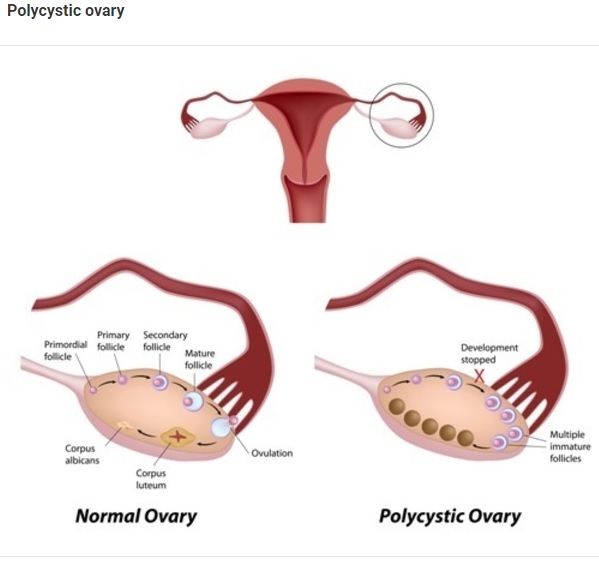Description
Polycystic ovary syndrome is a condition that affects women in their child-bearing years and alters the levels of multiple hormones, resulting in problems affecting many body systems.
Most women with polycystic ovary syndrome produce excess male sex hormones (androgens), a condition called hyperandrogenism. Having too much of these hormones typically leads to excessive body hair growth (hirsutism), acne, and male pattern baldness.
Hyperandrogenism and abnormal levels of other sex hormones prevent normal release of egg cells from the ovaries (ovulation) and regular menstrual periods, leading to difficulty conceiving a child (subfertility) or a complete inability to conceive (infertility). For those who achieve pregnancy, there is an increased risk of complications and pregnancy loss. Due to irregular and infrequent menstruation and hormone abnormalities, affected women have an increased risk of cancer of the uterine lining (endometrial cancer).

In polycystic ovary syndrome, multiple cysts in each ovary can be seen with medical imaging. These cysts are small, immature ovarian follicles. Normally, ovarian follicles contain egg cells, which are released during ovulation. In polycystic ovary syndrome, abnormal hormone levels prevent follicles from growing and maturing to release egg cells. Instead, these immature follicles accumulate in the ovaries. Affected women can have 12 or more of these follicles. The number of these follicles usually decreases with age.
About half of all women with polycystic ovary syndrome are overweight or obese and are at increased risk of a fatty liver. Additionally, many women with polycystic ovary syndrome have elevated levels of insulin, which is a hormone that helps control
blood sugar levels. By age 40, about 10 percent of overweight women with polycystic ovary syndrome develop abnormally high blood sugar levels (type 2 diabetes), and up to 35 percent develop prediabetes (higher-than-normal blood sugar levels that do not reach the cutoff for diabetes). Obesity and increased insulin levels (hyperinsulinemia) further increase the production of androgens in polycystic ovary syndrome.
Women with polycystic ovary syndrome are also at increased risk for developing metabolic syndrome, which is a group of conditions that include high blood pressure (hypertension), increased belly fat, high levels of unhealthy fats and low levels of healthy fats in the blood, and high blood sugar levels. About 20 percent of affected adults experience pauses in breathing during sleep (sleep apnea). Women with polycystic ovary syndrome are more likely to have mood disorders such as depression compared to the general population.
Frequency
Polycystic ovary syndrome is the most common cause of infertility due to absent ovulation. The prevalence of polycystic ovary syndrome is often reported as 6 to 10 percent of women worldwide. However, some studies report a wider range, from as low as 4 percent to as high as 21 percent of women, depending on the criteria used to make the diagnosis.
Causes
The causes of polycystic ovary syndrome are complex. This condition results from a combination of genetic, health, and lifestyle factors, some of which have not been identified. Common variations (polymorphisms) in several genes have been associated with the risk of developing polycystic ovary syndrome. Because they are common, these variations can be present in people with polycystic ovary syndrome and in those without. It is the combination of these changes that helps determine a woman’s likelihood of developing the disease.
Genes that are involved in many body processes are thought to play a role in the development of polycystic ovary syndrome. The main contributors are likely genetic variants that increase the production of androgen and other sex hormones such as luteinizing hormone and anti-Mullerian hormone, which both play key roles in ovulation. Other genetic variants likely involved in a decrease in follicle-stimulating hormone are thought to contribute to the poor development of follicles in women with polycystic ovary syndrome.
Other genes associated with polycystic ovary syndrome are involved in energy production, immune system responses to injury (inflammation), insulin production and regulation, and pathways involved in the production of fats.
Genetic variations likely act in combination with health and lifestyle factors to influence a woman’s overall risk of developing polycystic ovary syndrome. Risk factors include diabetes, obesity, and a largely inactive (sedentary) lifestyle.

